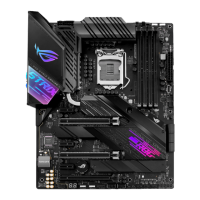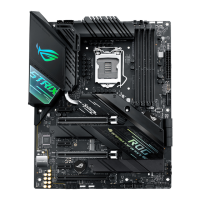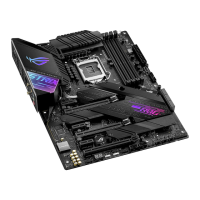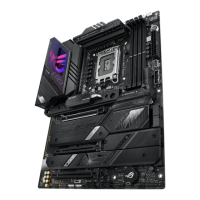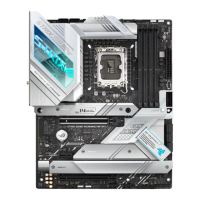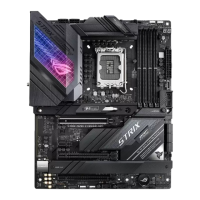
Do you have a question about the Asus Strix Z270I Gaming and is the answer not in the manual?
| Form Factor | Mini ITX |
|---|---|
| Socket | LGA 1151 |
| Chipset | Intel Z270 |
| Memory Slots | 2 |
| Max Memory Support | 32 GB |
| Memory Type | DDR4 |
| PCIe Slots | 1 x PCIe 3.0 x16 |
| SATA 6Gb/s Ports | 4 |
| M.2 Slots | 2 |
| USB 3.1 Gen 1 Ports | 4 |
| USB 2.0 Ports | 4 |
| Memory Speed | 2400/2666/2800/3000/3200 MHz (OC) |
| LAN | Intel® I219V |
| Wi-Fi | 802.11 a/b/g/n/ac |
| Bluetooth | Bluetooth V4.1 |
| Audio | SupremeFX S1220A 8-Channel HD Audio |
| USB 3.1 Gen 2 Ports | 2 |
| RGB Headers | 2 |
Precautions to prevent electrical shock hazards when handling the system.
Guidelines for safe installation and handling of motherboard components.
Explains the manual's structure and where to find additional information.
Defines symbols and text formatting used throughout the manual.
Details on CPU socket, chipset, and memory module support.
Information on PCIe slots, graphics outputs, network, and USB ports.
Specifications for audio codec, Wi-Fi, Bluetooth, and ROG features.
Lists internal headers, BIOS features, and OS compatibility.
Introduces the motherboard and its general layout.
Detailed diagram of motherboard components and connectors.
Describes the CPU socket and installation considerations.
Information on DIMM slots and memory configuration.
Details on PCIe slots and IRQ assignments.
Explains Clear RTC RAM and Battery headers.
Description of POST State LEDs and RGB LED lighting.
Details on front panel audio, SATA, USB, TPM, and sensor connectors.
Step-by-step guide for installing motherboard, CPU, and memory.
Instructions for connecting ATX power, SATA devices, and front panel I/O.
Guide for installing expansion cards, M.2 SSDs, and Wi-Fi antennas.
Details on rear panel connectors and audio port configurations.
Steps for the initial system startup and how to turn off the computer.
Introduction to UEFI BIOS and its function.
How to enter and navigate the BIOS setup utility.
Overview of the EZ Mode interface for basic system information.
Accessing and navigating the Advanced Mode for detailed settings.
Explanation of menu bar, keys, and on-screen help.
Fan speed control settings for CPU and chassis fans.
Steps to manually adjust fan speed points in Q-Fan Control.
Automated overclocking and RAID setup utility.
Guide to using EZ Tuning Wizard for CPU and DRAM overclocking.
Steps to configure RAID arrays using EZ Tuning Wizard.
Personalized BIOS settings space for quick access.
Instructions on how to add BIOS items to the Favorites menu.
Overview of system information and basic settings in Advanced Mode.
Options for setting BIOS passwords and system security.
Settings for overclocking CPU, DRAM, and other performance parameters.
Selecting overclocking modes like Auto, Manual, or XMP.
Adjusting the Base Clock frequency for system performance.
Configuring CPU core ratios and MultiCore Enhancement.
Memory frequency settings and TPU for performance enhancement.
Advanced system configuration options.
Details on CPU-related information and Hyper-Threading settings.
Settings for PCH and SA PCI Express.
Configuration options for PCI Express.
SATA device detection and configuration options.
Enabling/disabling SATA controllers and setting SATA mode.
Enabling/disabling onboard audio, LAN, and RGB LED.
Power management settings including ErP Ready.
Settings for USB devices and port control.
Displays system temperature, power status, and fan settings.
Options for boot device priority and boot behavior.
Switching between EZ/Advanced modes and CSM settings.
Utilities for special functions like BIOS updates and secure erase.
Utility for updating the BIOS from USB or Internet.
Tool to securely erase SSD contents.
Saving and loading BIOS settings profiles.
Options to load defaults, save, or discard changes and exit.
Instructions and precautions for updating the motherboard BIOS.
Overview of supported RAID levels and definitions.
Guidelines for installing SATA drives for RAID arrays.
Steps to configure Intel RST in the BIOS.
Using the utility to manage RAID volumes.
Procedure for creating RAID volumes via BIOS.
Procedure for deleting RAID volumes.
Instructions for creating a RAID driver disk for OS installation.
FCC, IC, VCCI, and KC compliance statements.
REACH, recycling, RF exposure, and regional notices.
License terms and ASUS global contact information.





